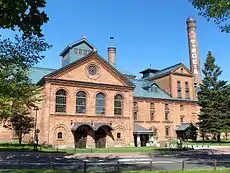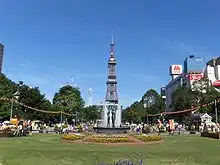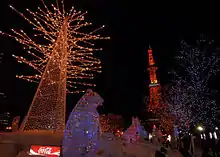Sapporo
Sapporo (札幌市, Sapporo-shi) is the largest Japanese city north of Tokyo and thus the largest city on Hokkaido, which is Japans northernmost main island. It is the capital city of Hokkaido Prefecture and Ishikari Subprefecture. Sapporo lies in the southwest of Hokkaido, within the alluvial fan of the Toyohira River, which is a tributary stream of the Ishikari. Sapporo is considered the cultural, economic, and political center of Hokkaido.
Sapporo
札幌市 | |||||||||||||
|---|---|---|---|---|---|---|---|---|---|---|---|---|---|
| City of Sapporo[1] | |||||||||||||
Left to right, top to bottom: Mount Moiwa night view, Sapporo Clock Tower, Sapporo Beer Museum, Sapporo Station, Hokkaido University, Sapporo Dome, and Sapporo TV Tower seen from Odori Park | |||||||||||||
 Flag  Seal | |||||||||||||
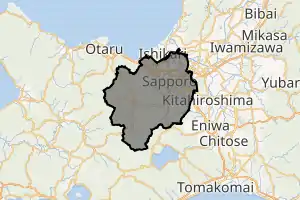
Location of Sapporo in Hokkaido (Ishikari Subprefecture) | |||||||||||||
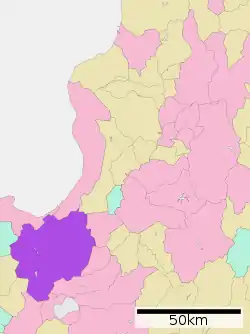 | |||||||||||||
 Sapporo Location in Japan 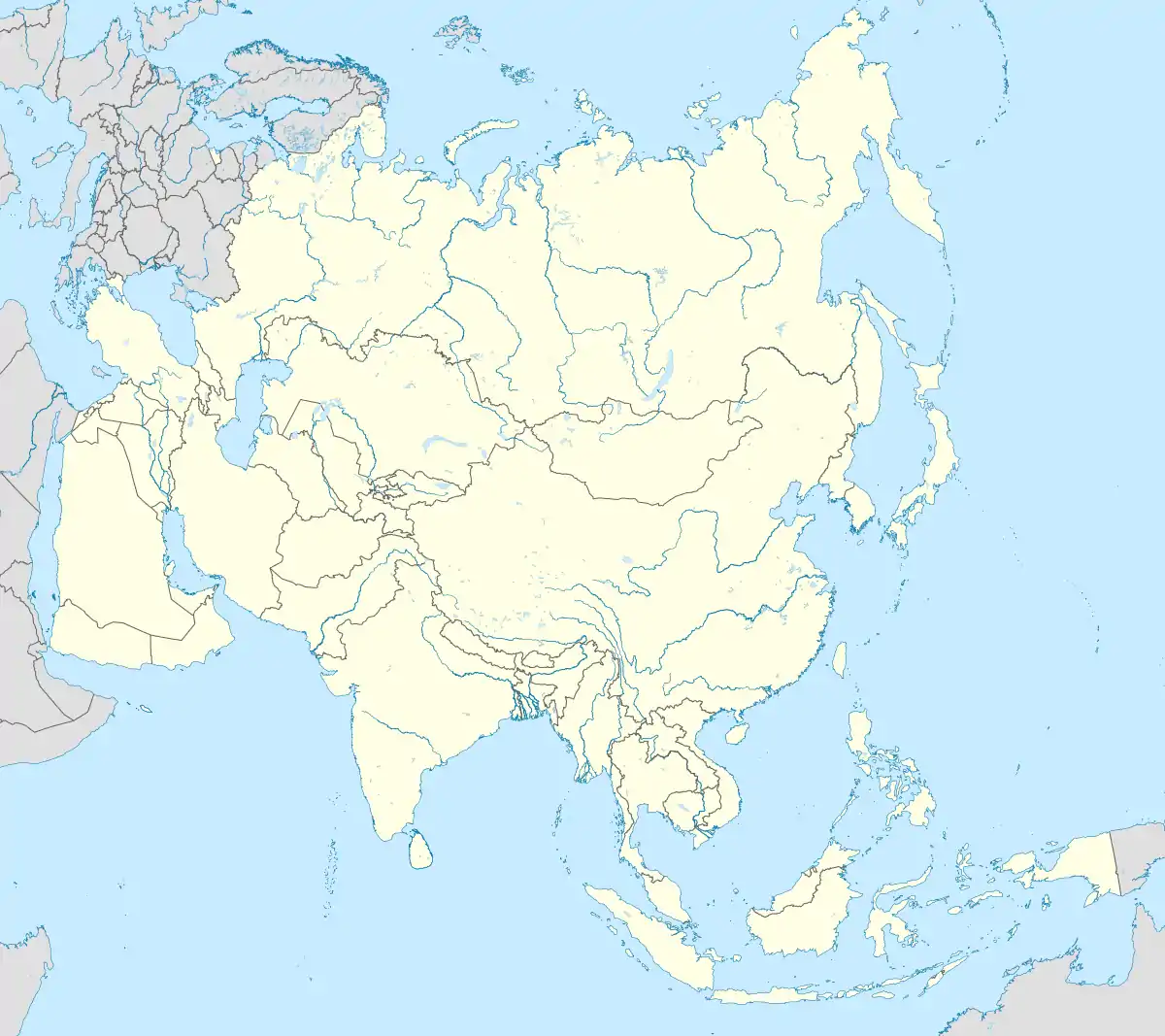 Sapporo Sapporo (Asia) .svg.png.webp) Sapporo Sapporo (Earth) | |||||||||||||
| Coordinates: 43°4′N 141°21′E | |||||||||||||
| Country | Japan | ||||||||||||
| Region | Hokkaido | ||||||||||||
| Prefecture | Hokkaido (Ishikari Subprefecture) | ||||||||||||
| Government | |||||||||||||
| • Mayor | Katsuhiro Akimoto | ||||||||||||
| • Vice Mayor | Katsuhiro Akimoto | ||||||||||||
| Area | |||||||||||||
| • Total | 1,121.26 km2 (432.92 sq mi) | ||||||||||||
| Population (Feb 1, 2020) | |||||||||||||
| • Total | 1,970,277 | ||||||||||||
| • Density | 1,800/km2 (4,600/sq mi) | ||||||||||||
| Time zone | UTC+09:00 (JST) | ||||||||||||
| City hall address | 2-1-1 Kita-ichijō-nishi, Chūō-ku, Sapporo-shi, Hokkaido 060-8611 | ||||||||||||
| Website | www | ||||||||||||
| |||||||||||||
| Sapporo | |||||
|---|---|---|---|---|---|
"Sapporo" in kanji | |||||
| Japanese name | |||||
| Kanji | 札幌 | ||||
| Hiragana | さっぽろ | ||||
| Katakana | サッポロ | ||||
| |||||
As with most of Hokkaido, the Sapporo area was settled by the indigenous Ainu people, beginning over 15,000 years ago. Starting in the late 19th century, Sapporo saw increasing settlement by Japanese migrants. Sapporo hosted the 1972 Winter Olympics, the first Winter Olympics ever held in Asia, and the second Olympic games held in Japan after the 1964 Summer Olympics. The Sapporo Dome hosted three games during the 2002 FIFA World Cup and two games during the 2019 Rugby World Cup. Additionally, Sapporo has hosted the Asian Winter Games three times, in 1986, 1990, and 2017.
The annual Sapporo Snow Festival draws more than 2 million tourists from abroad.[2] Other notable sites include the Sapporo Beer Museum, which is the only beer museum in Japan,[3] and the Sapporo TV Tower located in Odori Park. It is home to Hokkaido University, just north of Sapporo Station. The city is served by Okadama Airport and New Chitose Airport in nearby Chitose.
Etymology
Sapporo's name was taken from Ainuic "sat poro pet" (サッ・ポロ・ペッ), which can be translated as the "dry, great river", a reference to the Toyohira River.[4]
History
Early history
Before its establishment, the area occupied by Sapporo (known as the Ishikari Plain) was home to a number of indigenous Ainu settlements.[5] In 1866, at the end of the Edo period, construction began on a canal through the area, encouraging a number of early settlers to establish Sapporo village.[6]
In 1868, the officially recognized year celebrated as the "birth" of Sapporo, the new Meiji government concluded that the existing administrative center of Hokkaido, which at the time was the port of Hakodate, was in an unsuitable location for defense and further development of the island. As a result, it was determined that a new capital on the Ishikari Plain should be established. The plain itself provided an unusually large expanse of flat, well drained land which is relatively uncommon in the otherwise mountainous geography of Hokkaido.
During 1870–1871, Kuroda Kiyotaka, vice-chairman of the Hokkaido Development Commission (Kaitaku-shi), approached the American government for assistance in developing the land. As a result, Horace Capron, Secretary of Agriculture under President Ulysses S. Grant, became an oyatoi gaikokujin and was appointed as a special advisor to the commission. Construction began around Odori Park, which still remains as a green ribbon of recreational land bisecting the central area of the city. The city closely followed a grid plan with streets at right-angles to form city blocks.
The continuing expansion of the Japanese into Hokkaido continued, mainly due to migration from the main island of Honshu immediately to the south, and the prosperity of Hokkaido and particularly its capital grew to the point that the Development Commission was deemed unnecessary and was abolished in 1882.
Edwin Dun came to Sapporo to establish sheep and cattle ranches in 1876. He also demonstrated pig raising and the making of butter, cheese, ham and sausage. He was married twice, to Japanese women. He once went back to the US in 1883 but returned to Japan as a secretary of government.
William S. Clark, who was the president of the Massachusetts Agricultural College (now the University of Massachusetts Amherst), came to be the founding vice-president of the Sapporo Agricultural College (now Hokkaido University) for only eight months from 1876 to 1877. He taught academic subjects in science and lectured on the Bible as an "ethics" course, introducing Christian principles to the first entering class of the College.
In 1880, the entire area of Sapporo was renamed as "Sapporo-ku" (Sapporo Ward),[7] and a railroad between Sapporo and Temiya, Otaru was laid. That year the Hōheikan, a hotel and reception facility for visiting officials and dignitaries, was erected adjacent to the Odori Park. It was later moved to Nakajima Park where it remains today. Two years later, with the abolition of the Kaitaku-shi, Hokkaidō was divided into three prefectures: Hakodate, Sapporo, and Nemuro. The name of the urban district in Sapporo remained Sapporo-ku, while the rest of the area in Sapporo-ku was changed to Sapporo-gun. The office building of Sapporo-ku was also located in the urban district.[7]
Sapporo, Hakodate, and Nemuro Prefectures were abolished in 1886, and Hokkaidō government office building, an American-neo-baroque-style structure with red bricks, constructed in 1888. The last squad of the Tondenhei, the soldiers pioneering Hokkaido, settled in the place where the area of Tonden in Kita-ku, Sapporo is currently located. Sapporo-ku administered surrounding Sapporo-gun until 1899, when the new district system was announced. After that year, Sapporo-ku was away from the control of Sapporo-gun.[7] The "ku" (district) enforced from 1899 was an autonomy which was a little bigger than towns, and smaller than cities. In Hokkaido at that time, Hakodate-ku and Otaru-ku also existed.[8]
- Gallery
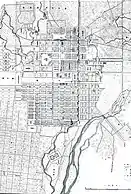 Sapporo city map in 1891
Sapporo city map in 1891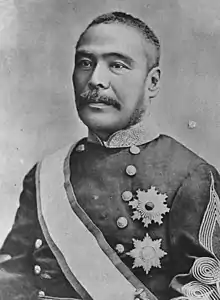
20th century
In 1907, the Tohoku Imperial University was established in Sendai Miyagi Prefecture, and Sapporo Agricultural College was controlled by the University. Parts of neighbouring villages including Sapporo Village, Naebo Village, Kami Shiroishi Village, and districts where the Tonden-hei had settled, were integrated into Sapporo-ku in 1910.
The Sapporo Streetcar was opened in 1918, and Hokkaido Imperial University was established in Sapporo-ku, as the fifth Imperial University in Japan. Another railroad operated in Sapporo, the Jōzankei Railroad, which was ultimately abolished in 1969.
In 1922, the new city system was announced by the Tokyo government, and Sapporo-ku was officially changed to Sapporo City.[6] The Sapporo Municipal Bus System was started in 1930. In 1937, Sapporo was chosen as the site of the 1940 Winter Olympics, but due to the outbreak of the Second Sino-Japanese War, this was cancelled the next year. Maruyama Town was integrated as a part of Chūō-ku in 1940, and the Okadama Airport was constructed in 1942.
The first Sapporo Snow Festival was held in 1950. In the same year, adjacent Shiroishi Village was integrated into Sapporo City, rendered as a part of Shiroishi-ku, and Atsubetsu-ku.[9] In 1955, Kotoni Town, the entire Sapporo Village, and Shinoro Village were merged into Sapporo, becoming a part of the current Chūō-ku, Kita-ku, Higashi-ku, Nishi-ku, and Teine-ku.[9] The expansion of Sapporo continued, with the merger of Toyohira Town in 1961, and Teine Town in 1967, each becoming a part of Toyohira-ku, Kiyota-ku, and Teine-ku.[9]
The ceremony commemorating the 100th anniversary of the foundation of Sapporo and Hokkaido was held in 1968. The Sapporo Municipal Subway system was inaugurated in 1971, which made Sapporo the fourth city in Japan to have a subway system. From February 3 to 13, 1972, the 1972 Winter Olympics were held, the first Winter Olympics held in Asia.[6] On April 1 of the same year, Sapporo was designated as one of the cities designated by government ordinance, and seven wards were established.[9] The last public performance by the opera singer, Maria Callas, was in Sapporo at the Hokkaido Koseinenkin Kaikan on 11 November 1974.[10] The Sapporo Municipal Subway was expanded when the Tōzai line started operation in 1976, and the Tōhō line was opened in 1988. In 1989, Atsubetsu-ku and Teine-ku were separated from Shiroishi-ku and Nishi-ku. Annual events in Sapporo were started, such as the Pacific Music Festival in 1990, and Yosakoi Sōran Festival in 1992. A professional football club, Consadole Sapporo, was established in 1996. In 1997, Kiyota-ku was separated from Toyohira-ku. In the same year, Hokkaidō Takushoku Bank, a Hokkaido-based bank with headquarters in Odori, went bankrupt.[11]
- Gallery
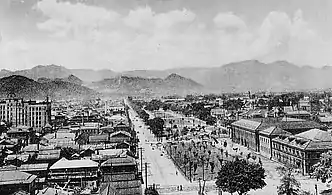 Odori Park in 1936
Odori Park in 1936
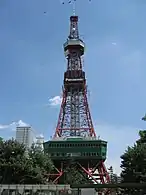 The Sapporo TV Tower was built in 1957
The Sapporo TV Tower was built in 1957
21st century
In 2001 the construction of the Sapporo Dome was completed, and in 2002 the Dome hosted three games during the 2002 FIFA World Cup; Germany vs Saudi Arabia, Argentina vs England and Italy vs Ecuador, all of which were in the first round. Fumio Ueda, was elected as Sapporo mayor for the first time in 2003. Sapporo became the home to a Nippon Professional Baseball team, Hokkaido Nippon-Ham Fighters, in 2004, which won the 2006 Japan Series, and the victory parade was held on Ekimae-Dōri (a street in front of Sapporo Station) in February 2007.
The 34th G8 summit took place in Tōyako in 2008, and a number of people including anti-globalisation activists marched in the heart of the city to protest. Police officers were gathered in Sapporo from all over Japan, and the news reported that four people were arrested in the demonstrations.[12]
The Hokkaidō Shinkansen line, which currently connects Honshu to Hakodate through the Seikan Tunnel, is planned to link to Sapporo by 2030.[13]
- Gallery
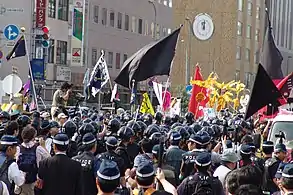 The 34th G8 summit protest march in 2008
The 34th G8 summit protest march in 2008
Geography
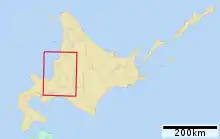
Sapporo is a city located in the southwest part of Ishikari Plain and the alluvial fan of the Toyohira River, a tributary stream of the Ishikari River.[14] It is part of Ishikari Subprefecture. Roadways in the urban district are laid to make a grid plan. The western and southern parts of Sapporo are occupied by a number of mountains including Mount Teine, Maruyama, and Mount Moiwa, as well as many rivers including the Ishikari River, Toyohira River, and Sōsei River. Sapporo has an elevation of 29 m (95 ft 2 in)[15]
Sapporo has many parks, including Odori Park, which is located in the heart of the city and hosts a number of annual events and festivals throughout the year. Moerenuma Park is also one of the largest parks in Sapporo, and was constructed under the plan of Isamu Noguchi, a Japanese-American artist and landscape architect.
Neighbouring cities are Ishikari, Ebetsu, Kitahiroshima, Eniwa, Chitose, Otaru, Date, and adjoining towns are Tōbetsu, Kimobetsu, Kyōgoku.
Wards
Sapporo has ten wards (区, ku). The color shows the location of each ku in the map below.
| Wards of Sapporo | |||||||
|---|---|---|---|---|---|---|---|
| Place Name | Map of Sapporo | ||||||
| Rōmaji | Kanji | Color | Population | Land area in km2 | Pop. density
per km2 |
||
| 1 | Atsubetsu-ku | 厚別区 | (purple) | 127,299 | 24.38 | 5,221 | 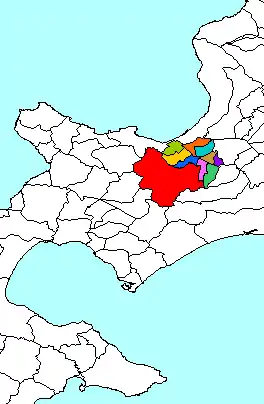 A map of Sapporo's Wards |
| 2 | Chūō-ku – administrative center | 中央区 | (blue) | 237,761 | 46.42 | 5,122 | |
| 3 | Higashi-ku | 東区 | (skyblue) | 261,901 | 56.97 | 4,597 | |
| 4 | Kita-ku | 北区 | (orange-red) | 286,026 | 63.57 | 4,499 | |
| 5 | Kiyota-ku | 清田区 | (green) | 113,556 | 59.87 | 1,897 | |
| 6 | Minami-ku | 南区 | (red) | 136,774 | 657.48 | 208 | |
| 7 | Nishi-ku | 西区 | (orange) | 216,835 | 75.10 | 2,887 | |
| 8 | Shiroishi-ku | 白石区 | (brown) | 213,310 | 34.47 | 6,188 | |
| 9 | Teine-ku | 手稲区 | (forest green) | 141,886 | 56.77 | 2,499 | |
| 10 | Toyohira-ku | 豊平区 | (pink) | 223,408 | 46.23 | 4,833 | |
Cityscape
- Gallery
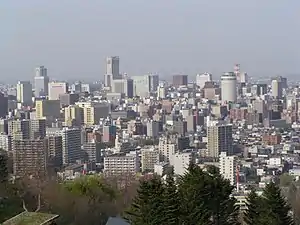 Sapporo City Skyline (2009)
Sapporo City Skyline (2009)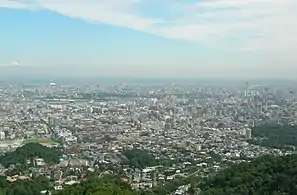 Sapporo in 2006
Sapporo in 2006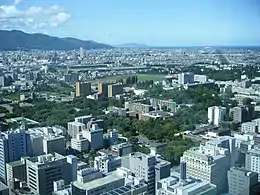 A view of Sapporo city and Hokkaidō University (2009)
A view of Sapporo city and Hokkaidō University (2009)
Climate
Sapporo has a humid continental climate (Köppen: Dfa), with a wide range of temperature between the summer and winter. Summers are generally warm and humid, but not oppressively hot, and winters are cold and very snowy, with an average snowfall of 5.96 m (19 ft 7 in) per year.[16] Sapporo is one of few metropolises in the world with such heavy snowfall,[17] enabling it to hold events and festivals with snow statues. The heavy snowfall is due to the Siberian High developing over the Eurasian land mass and the Aleutian Low developing over the northern Pacific Ocean, resulting in a flow of cold air southeastward across Tsushima Current and to western Hokkaido. The city's annual average precipitation is around 1,100 mm (43.3 in), and the mean annual temperature is 8.5 °C (47.3 °F).[14]
| Climate data for Sapporo, Hokkaido (1981–2010), extremes 1876–present | |||||||||||||
|---|---|---|---|---|---|---|---|---|---|---|---|---|---|
| Month | Jan | Feb | Mar | Apr | May | Jun | Jul | Aug | Sep | Oct | Nov | Dec | Year |
| Record high °C (°F) | 11.2 (52.2) |
10.8 (51.4) |
16.8 (62.2) |
28.0 (82.4) |
34.2 (93.6) |
33.7 (92.7) |
36.0 (96.8) |
36.2 (97.2) |
32.7 (90.9) |
26.4 (79.5) |
22.4 (72.3) |
14.8 (58.6) |
36.2 (97.2) |
| Average high °C (°F) | −0.6 (30.9) |
0.1 (32.2) |
4.0 (39.2) |
11.5 (52.7) |
17.3 (63.1) |
21.5 (70.7) |
24.9 (76.8) |
26.4 (79.5) |
22.4 (72.3) |
16.2 (61.2) |
8.5 (47.3) |
2.1 (35.8) |
12.9 (55.2) |
| Daily mean °C (°F) | −3.6 (25.5) |
−3.1 (26.4) |
0.6 (33.1) |
7.1 (44.8) |
12.4 (54.3) |
16.7 (62.1) |
20.5 (68.9) |
22.3 (72.1) |
18.1 (64.6) |
11.8 (53.2) |
4.9 (40.8) |
−0.9 (30.4) |
8.9 (48.0) |
| Average low °C (°F) | −7 (19) |
−6.6 (20.1) |
−2.9 (26.8) |
3.2 (37.8) |
8.3 (46.9) |
12.9 (55.2) |
17.3 (63.1) |
19.1 (66.4) |
14.2 (57.6) |
7.5 (45.5) |
1.3 (34.3) |
−4.1 (24.6) |
5.3 (41.5) |
| Record low °C (°F) | −27.0 (−16.6) |
−28.5 (−19.3) |
−22.6 (−8.7) |
−14.6 (5.7) |
−4.2 (24.4) |
0.0 (32.0) |
5.2 (41.4) |
5.3 (41.5) |
−0.9 (30.4) |
−4.4 (24.1) |
−15.5 (4.1) |
−24.7 (−12.5) |
−28.5 (−19.3) |
| Average precipitation mm (inches) | 113.6 (4.47) |
94.0 (3.70) |
77.8 (3.06) |
56.8 (2.24) |
53.1 (2.09) |
46.8 (1.84) |
81.0 (3.19) |
123.8 (4.87) |
135.2 (5.32) |
108.7 (4.28) |
104.1 (4.10) |
111.7 (4.40) |
1,106.5 (43.56) |
| Average snowfall cm (inches) | 173 (68) |
147 (58) |
98 (39) |
11 (4.3) |
0 (0) |
0 (0) |
0 (0) |
0 (0) |
0 (0) |
2 (0.8) |
32 (13) |
132 (52) |
597 (235) |
| Average precipitation days (≥ 0.5 mm) | 21.8 | 19.0 | 18.5 | 11.7 | 10.2 | 8.3 | 9.7 | 9.5 | 11.1 | 13.9 | 17.5 | 19.2 | 170.3 |
| Average snowy days | 28.8 | 25.4 | 23.5 | 6.4 | 0.1 | 0.0 | 0.0 | 0.0 | 0.0 | 1.2 | 13.9 | 26.5 | 125.9 |
| Average relative humidity (%) | 70 | 69 | 66 | 62 | 66 | 72 | 76 | 75 | 71 | 67 | 67 | 69 | 69 |
| Mean monthly sunshine hours | 92.5 | 104.0 | 146.6 | 176.5 | 198.4 | 187.8 | 164.9 | 171.0 | 160.5 | 152.3 | 100.0 | 85.9 | 1,740.4 |
| Average ultraviolet index | 1 | 2 | 3 | 5 | 6 | 7 | 8 | 8 | 6 | 3 | 2 | 1 | 4 |
| Source: Japan Meteorological Agency (records 1876–present)[18][19][20] and Weather Atlas[21] | |||||||||||||
Demographics
The first census of the population of Sapporo was taken in 1873, when 753 families with a total of 1,785 people were recorded in the town.[22] The city has an estimated population of 1,957,914 as of May 31, 2019 and a population density of 1,746 persons per km² (4,500 persons per mi²). The total area is 1,121.26 km2 (432.92 sq mi).
| Year | Pop. | ±% |
|---|---|---|
| 1873 | 1,785 | — |
| 1920 | 105,182 | +5792.5% |
| 1925 | 149,314 | +42.0% |
| 1930 | 174,179 | +16.7% |
| 1935 | 196,541 | +12.8% |
| 1940 | 206,103 | +4.9% |
| 1950 | 313,850 | +52.3% |
| 1955 | 426,620 | +35.9% |
| 1960 | 523,839 | +22.8% |
| 1965 | 794,908 | +51.7% |
| 1970 | 1,010,123 | +27.1% |
| 1975 | 1,240,613 | +22.8% |
| 1980 | 1,401,757 | +13.0% |
| 1985 | 1,542,979 | +10.1% |
| 1990 | 1,671,742 | +8.3% |
| 1995 | 1,757,025 | +5.1% |
| 2000 | 1,822,368 | +3.7% |
| 2005 | 1,880,863 | +3.2% |
| 2010 | 1,913,545 | +1.7% |
| 2015 | 1,952,356 | +2.0% |
| Source: Statistics Bureau | ||
Economy
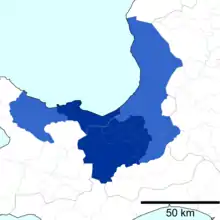
The tertiary sector dominates Sapporo's industry. Major industries include information technology, retail, and tourism, as Sapporo is a destination for winter sports and events and summer activities due to its comparatively cool climate.[23]
The city is also the manufacturing centre of Hokkaido, manufacturing various goods such as food and related products, fabricated metal products, steel, machinery, beverages, and pulp and paper.[24]
Hokkaido International Airlines (Air Do) is headquartered in Chūō-ku.[25] In April 2004, Air Nippon Network was headquartered in Higashi-ku.[26] Other companies headquartered in Sapporo include Crypton Future Media, DB-Soft, Hokkaido Air System, and Royce'.
Greater Sapporo, Sapporo Metropolitan Employment Area (2.3 million people), had a total GDP of US$84.7 billion in 2010.[27][28]
In 2014, Sapporo's GDP per capita (PPP) was US$32,446.[29]
Culture and entertainment
Music
- 1934 – The International Contemporary Music Festival was held by Akira Ifukube, Fumio Hayasaka, Atsushi Miura, and Isamu Ifukube (30 September)
- 1936 – Russian composer Alexander Tcherepnin visited Sapporo
- 1960 – The Sapporo Symphony Orchestra founded
- 1962 – John Cage and David Tudor visited Sapporo
- 1966 – Berliner Philharmoniker with Herbert von Karajan performed Brahms's Symphony No. 2 at Sapporo Shimin Kaikan (April)
- 1974 – Maria Callas last public performance at the Hokkaido Koseinenkin Kaikan (11 November)
- 1986 – The Sapporo Art Park include the Outdoor Stage and Art Hall (27 July)
- 1990 – The Pacific Music Festival (PMF) started
- 1997 – The Sapporo Concert Hall Kitara opened
- 2018 – The Sapporo Community Plaza is set to open in October
Art
- The Hokkaido Museum of Modern Art represents Hokkaido artists like Eien Iwahashi, Kinjiro Kida, Nissho Kanda, Tamako Kataoka, and especially glass objects of Ecole de Paris
- The Hongō Shin Memorial Museum of Sculpture hosts a collection of over 1,800 works by the artist Hongō Shin.[30]
- The Sapporo Art Park contains Art museum featuring outdoor installations & a sculpture garden, and the old house of Takeo Arishima.
- The Moerenuma Park including the Glass Pyramid, designed by Isamu Noguchi
- The Migishi Kotaro Museum of Art
- The Hongo Shin Memorial Museum of Sculpture
- The Miyanomori Art Museum
- The Sapporo Odori 500-m Underground Walkway Gallery
- Member of UNESCO Creative Cities Network as a Creative City of Media Arts since 2013
- Sapporo International Art Festival (2014/2017)
Literature
- The Hokkaido Museum of Literature
- Takeo Arishima Residence in Sapporo Art Park
- Junichi Watanabe Museum of Literature
Film
- The Idiot (1951 film) by Akira Kurosawa
- The Northern Museum of Visual Culture
- Theater Kino
- The Sapporo International Short Film Festival and Market
Points of interest
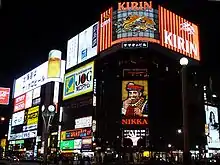
Registered Tangible Cultural Properties in Sapporo
- The former Hokkaidō government office building
- The Sapporo Clock Tower
- The Hokkaidō Shrine
- Hokkaido Museum
- Historical Village of Hokkaido
- Sapporo Buried Cultural Property Center
- The Sapporo City Archive Museum (Former Sapporo Court of Appeal)
- The Edwin Dun Memorial Hall
- The Hokkaido University & Hokkaido University Museum
- The Sapporo Beer Museum & Sapporo Factory
- The Sapporo TV Tower
- The Sapporo Convention Center
- The Sapporo Salmon Museum in Makomanai Park
- The Sunpiazza Aquarium
Sapporo JR Tower adjacent to Sapporo Station.[31]
Sapporo Ramen Yokocho and Norubesa (a building with a Ferris wheel) are in Susukino district. The district also has the Tanuki Kōji Shopping Arcade, the oldest shopping mall in the city.
The district of Jōzankei in Minami-ku has many resort hotels with steam baths and onsen.
The Peace Pagoda, one of many such monuments across the world built by the Buddhist order Nipponzan Myohoji to promote and inspire world peace, has a stupa that was built in 1959, halfway up Mount Moiwa, to commemorate peace after World War II. It contains some of the ashes of the Buddha that were presented to the Emperor of Japan by Prime Minister Nehru in 1954. Another portion was presented to Mikhail Gorbachev by the Nipponzan-Myohoji monk, Junsei Terasawa.
Parks/gardens
- The Odori Park
- The Nakajima Park
- The Maruyama Park is located next to the Hokkaido Shrine and houses the Maruyama Zoo.
- The Moerenuma Park
- The Nishioka Park is a location of rich nature which centers around a pond and consists of marshland and the forest of the Tsukisamu River and its upper river basin. This park also serves as one of the main habitats in Hokkaido for many types of wild birds.
- The Asahiyama Memorial Park offers great views of the city.
- The Hokkaido University Botanical Gardens and The Chizaki Rose Garden
- The Hitsujigaoka Observation Hill has a farm with sheep and attracts visitors with a statue of William S. Clark.
Events/festivals
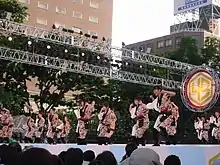
February: the Sapporo Snow Festival The main site is at Odori Park, and other sites include Susukino (known as the Susukino Ice Festival) and Sapporo Satoland. Many of the snow and ice statues are built by members of the Japan Ground Self-Defense Force.[32]
May: the Sapporo Lilac Festival. Lilac was brought to Sapporo in 1889 by an American educator, Sarah Clara Smith. At the festival, people enjoy the flowers, wine and live music.
June: the Yosakoi Soran Festival. The sites of the festival are centered on Odori Park and the street leading to Susukino, and there are other festival sites. In the festival, many dance teams dance to music composed based on a Japanese traditional song, "Sōran Bushi". Members of the dancing teams wear special costumes and compete on the roads or stages constructed on the festival sites. In 2006, 350 teams were featured with around 45,000 dancers, and over 1,860,000 people visited the festival.[32]
the Sapporo Summer Festival. People enjoy drinking at the beer garden in Odori Park and on the streets of Susukino. This festival consists of a number of fairs such as Tanuki Festival and Susukino Festival.[32]
September: the Sapporo Autumn Festival
December: Christmas market in Odori Park, similar to German Christmas markets.
From November through January, many citizens enjoy the Sapporo White Illuminations.
Cuisine
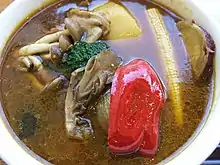
The city is known home to Sapporo Brewery, and the white chocolate biscuits 'shiroi koibito' (白い恋人), also as the birthplace of miso ramen.[33] The Kouraku Ramen Meitengai in Susukino district, an alley lined with many miso ramen restaurants since 1951. After its demolition due to plans for the Sapporo Olympics, the Ganso Sapporo Ramen Yokocho was established in the same place. It attracts many tourists throughout the year.[33] From the year 1966, a food company named Sanyo Foods began to sell instant ramen under the brand name "Sapporo Ichiban".
Haskap, a local variety of edible honeysuckle, similar to blueberries, is a specialty in Sapporo. Other specialty dishes of Sapporo are soup curry, a soupy curry made with vegetables and chicken or other meats, and jingisukan, a barbecued lamb dish, named for Genghis Khan. Sapporo Sweets is a confectionery using many ingredients from Hokkaido and the Sapporo Sweets Competition is held annually.[34] Sapporo is also well known for fresh seafood including salmon, sea urchin and crab. Crab in particular is famed. Many types of crab are harvested and served seasonally in Sapporo like the Horsehair crab, Snow crab, King crab, and Hanasaki crab with numerous dishes revolving around them.[35]
Sports
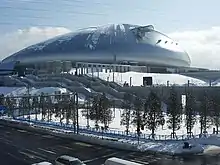
The Sapporo Dome was constructed in 2001 and currently is the host to the local professional teams, Hokkaido Consadole Sapporo (football), and Hokkaido Nippon-Ham Fighters (baseball).
Sapporo was selected to be the host of the 5th Winter Olympics scheduled on February 3 to 12, 1940, but Japan had to give the Games back to the IOC, after the Second Sino-Japanese War broke out in 1937.
In 1972, Sapporo hosted the 11th Winter Olympics. Some structures built for Olympic events remain in use today, including the ski jumps at Miyanomori and Okurayama. After considering a bid for the 2026 Winter Olympics, Olympic representatives in Sapporo have said that the city is considering a bid for the 2030 Winter Olympics. The city predicts it may cost as much as 456.5 billion yen ($4.3 billion) to host the games and is planning to have 90 percent of the facilities within half an hour of the Olympic village, according to a report published 12 May 2016. The Alpen course would be in Niseko, the world's second-snowiest resort, while the village would be next to the Sapporo Dome, the report said.[36] The plans were presented to the Japanese Olympic Committee on 8 November 2016.[37][38] In 2002, Sapporo hosted three group matches of the FIFA World Cup at the Sapporo Dome. In 2006, Sapporo hosted some games of the 2006 Basketball World Championship and also for the 2006 Women's Volleyball World Championship. In 2007, Sapporo hosted the FIS Nordic World Ski Championships at the Sapporo Dome, Miyanomori ski jump, Okurayama ski jump, and the Shirahatayama cross-country course. It has been host city of two Asian Winter Games and hosted the 2017 Asian Winter Games with Obihiro. Sapporo will also host some games during the 2019 Rugby World Cup.
Skiing remains a major sport in Sapporo with almost all children skiing as a part of the school curriculum. Okurayama Elementary School is unusual in having its own ski hill and ski jumping hill on the school grounds. Within the city are commercial ski hills including Moiwayama, Bankeiyama, KobaWorld, Sapporo Teine and Fu's.
Many sports stadiums and domes are located in Sapporo, and some of them have been designated as venues of sports competitions. The Sapporo Community Dome, also known by its nickname "Tsu-Dome", has hosted the Golden Market, a huge flea market event which is usually held twice a year, along with some sports events. The Makomanai Ice Arena, in Makomanai Park, was one of the venues of the Sapporo Olympics in 1972. It was renamed the Makomanai Sekisuiheim Ice Arena in 2007, when Sekisui Chemical Co., Ltd., acquired naming rights and renamed the arena after their real estate brand.[39] Other large sports venues include the Makomanai Open Stadium, Tsukisamu Dome, Maruyama Baseball Stadium, and the Hokkaido Prefectural Sports Center, which hosts the professional basketball team, Levanga Hokkaido.
Toyota Big Air is a major international snowboarding event held annually in Sapporo Dome. As one of the richest events of its kind in the world, it draws many of the world's best snowboarders.
Professional sport teams
| Club | Sport | League | Venue | Established |
|---|---|---|---|---|
| Hokkaido Nippon-Ham Fighters | Baseball | Nippon Professional Baseball | Sapporo Dome | 2004 |
| Levanga Hokkaido | Basketball | B.League Division 1 | Hokkaido Prefectural Sports Center, Tsukisamu Dome |
2006 |
| Hokkaido Consadole Sapporo | Football (soccer) | J1 League | Sapporo Atsubetsu Park Stadium, Sapporo Dome |
1996 |
- J.League – Hokkaido Consadole Sapporo (J1 in 1998, 2001–2002, 2008, 2012, 2017–present; J2 in 1999–2000, 2003–2007, 2009–2011, 2013–2016) .
- NPB – Hokkaido Nippon Ham Fighters in Pacific League
Transportation
Sapporo has one streetcar line, three JR Hokkaido lines, three subway lines and JR Bus, Chuo Bus and other bus lines. Sapporo Subway trains have rubber-tyred wheels.
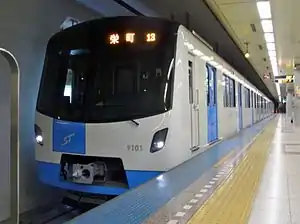
Rapid transit
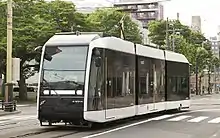
Rail
- JR Hokkaido Stations in Sapporo
- Hakodate Line: (Zenibako) – Hoshimi – Hoshioki – Inaho – Teine – Inazumi Kōen – Hassamu – Hassamu Chūō – Kotoni – Sōen – Sapporo – Naebo – Shiroishi – Atsubetsu – Shinrinkōen – (Ōasa)
- Chitose Line: Heiwa – Shin Sapporo – Kami Nopporo – (Kita-Hiroshima)
- Sasshō Line (Gakuentoshi Line): Sōen – Hachiken – Shinkawa – Shinkotoni – Taihei – Yurigahara – Shinoro – Takuhoku – Ainosato Kyōikudai – Ainosato Kōen – (Ishikari Futomi)
Air
The Sapporo area is served by two airports: Okadama Airport, which offers regional flights within Hokkaido, and New Chitose Airport, a larger international airport located in the city of Chitose 30 miles (48 km) away connected by regular rapid trains taking around 40 minutes. The Sapporo-Tokyo route between New Chitose and Haneda is one of the busiest in the world.
Airport shuttle, tour and charter bus service
An airport shuttle bus servicing all hotels in Sapporo operates every day of the year. SkyExpress was founded in 2005 and also provides transport to and from various ski resorts throughout Hokkaido, including Niseko.
Education
Universities
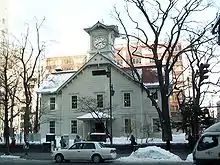
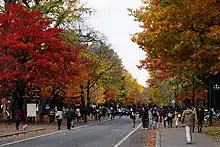
Private
- Sapporo University
- Hokusei Gakuen University
- Hokkai School of Commerce
- Hokkai Gakuen University
- Fuji Women's University
- Sapporo International University
- Tenshi College
- Health Sciences University of Hokkaido
- Sapporo Ōtani University
- Hokkaido Tokai University
- Hokkaido Musashi Women's Junior College
- Hokkaido Bunkyo University
- Hokkaido University of Science
- Koen Gakuen Women's Junior College
- Hokkaido Institute of Technology
- Hokkaido College of Pharmacy
- Sapporo University of Health Sciences
- Japan Health Care College
Primary and secondary schools
Sapporo Odori High School provides Japanese-language classes to foreign and Japanese returnee students, and the school has special admissions quotas for these groups.[40]
The city has two private international schools:
- Hokkaido International School
- Hokkaido Korean Primary, Middle and High School (North Korean school)
Twin towns – sister cities
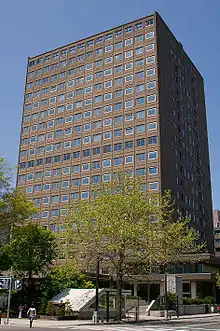
Sapporo has twinning relationships with several cities worldwide.[41][42]
 Portland, Oregon, United States, since 1959
Portland, Oregon, United States, since 1959 Munich, Bavaria, Germany, since 1972
Munich, Bavaria, Germany, since 1972 Shenyang, Liaoning, China, since 1980
Shenyang, Liaoning, China, since 1980 Novosibirsk, Russia, since 1990
Novosibirsk, Russia, since 1990 Daejeon, South Korea, since 2010
Daejeon, South Korea, since 2010 Chiclayo, Peru
Chiclayo, Peru
See also
References
- "City of Sapporo". City of Sapporo.
- さっぽろ雪まつり実行委員会. 前回のさっぽろ雪まつりの様子.
- Japan National Tourist Organization — Sapporo Beer Museum.
- ふるさとの川史話いっぱい. City of Sapporo.
- "Recognition at last for Japan's Ainu ". BBC News. July 6, 2008
- サイト閉鎖のお知らせ.
- New Sapporo History 2nd edition (新札幌市史 第2巻, Shin Sapporo Shishi)
- 北海道市町村自治制の沿革概要 (PDF) (in Japanese). Government of Hokkaido.
- New Sapporo History 5th edition (新札幌市史 第5巻, Shin Sapporo Shishi)
- Sutherland, Robert Maria Callas Diaries of a Friendship London Constable 1999 p265 ISBN 0-09-478790-5
- "lawsuit against the bankruptcy of the Takushoku Bank". Archived from the original on 2007-12-22. Retrieved 2007-10-07.
- "Arrests made during scuffles at G8 protest in Japan". 5 July 2008.
- "Celebrating the opening of the Hokkaido Shinkansen—travel by train from Hakodate to Sapporo while exploring along the way".
- 札幌市のあらまし. City of Sapporo.
- "Where is Sapporo, Japan?". worldatlas.com. Retrieved 10 June 2019.
- 気象庁 | 平年値(年・月ごとの値) (in Japanese). Japan Meteorological Agency.
- City of Sapporo. "General Overview of Sapporo" (PDF) (in English and Japanese). Archived from the original (PDF) on 5 February 2007. Retrieved 30 March 2018.
- 気象庁 / 平年値(年・月ごとの値). Japan Meteorological Agency. Retrieved December 23, 2016.
- 気象庁 / 平年値(年・月ごとの値) (in Japanese). Japan Meteorological Agency. Retrieved December 23, 2016.
- 観測史上1~10位の値( 年間を通じての値) (in Japanese). Japan Meteorological Agency. Retrieved December 17, 2014.
- d.o.o, Yu Media Group. "Sapporo, Japan - Detailed climate information and monthly weather forecast". Weather Atlas. Retrieved 2019-07-09.
- Japanese Imperial Commission (1878). Le Japon à l'exposition universelle de 1878. Géographie et histoire du Japon (in French). p. 31.
- Sapporo Winter Sport Museum Guide
- 工業統計調査/札幌市 (in Japanese). City of Sapporo.
- "会社概要 (in Japanese). Hokkaido International Airlines. Retrieved May 20, 2009.
- " 会社概要 (in Japanese). Air Nippon Network. April 6, 2004. Archived from the original on April 6, 2004. Retrieved May 20, 2009.
- Yoshitsugu Kanemoto. "Metropolitan Employment Area (MEA) Data". Center for Spatial Information Science, The University of Tokyo.
- Conversion rates - Exchange rates - OECD Data
- "Global Metro Monitor". 2015-01-22.
- "English Guide|Hongo Shin Memorial Museum of Sculpture,Sapporo". www.hongoshin-smos.jp. Retrieved 2020-01-22.
- Tourism Statistics of Sapporo Archived 2007-10-25 at the Wayback Machine, 2006, p.35 (pdf file)
- Tourism Statistics of Sapporo, 2006, p.29 (pdf file)
- 元祖さっぽろラーメン横丁公式サイト.
- "Sapporo, the sweets republic". Archived from the original on 2007-10-17. Retrieved 2007-10-11.
- Dwyer, Chris (12 November 2018). "Welcome to Sapporo, crab capital of Japan (and maybe even the world)". CNN. Retrieved 9 December 2019.
- Sapporo to Show JOC Plan for 2026 Olympic Winter Games After Rio
- 札幌で再びオリンピックを JOCに開催提案書 (in Japanese). NHK. 8 November 2016. Archived from the original on 8 November 2016. Retrieved 13 November 2016.
- "Olympics: Sapporo shows 2026 Winter Games plan to JOC". kyodonews.net. 8 November 2016. Retrieved 13 November 2016.
- Makomanai Sekisuiheim Ice Arena Homepage
- "Education" (Archive). City of Sapporo. Retrieved on October 12, 2015.
- 札幌市 – 国際交流 – 姉妹都市 (in Japanese). City of Sapporo.
- Sister Cities | International Community Bureau Archived 2012-07-12 at Archive.today (in Japanese)
External links
| Wikimedia Commons has media related to Sapporo. |
- Official Website
- Sapporo Travel
- Unesco Media City Sapporo
- Information on living in Sapporo for foreign residents
- Live view of Odori Park from Sapporo TV Tower (in Japanese)
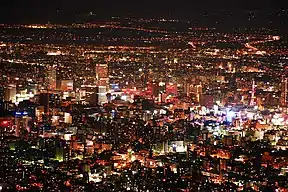
.jpg.webp)
